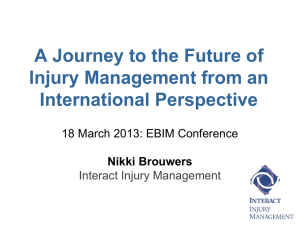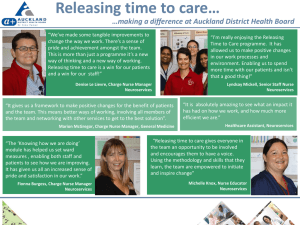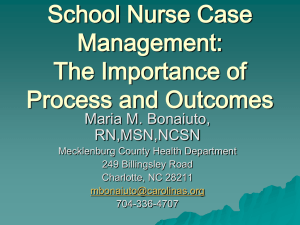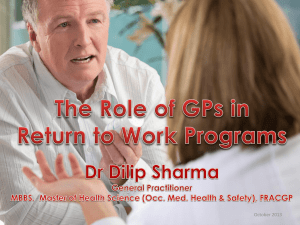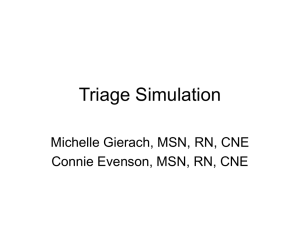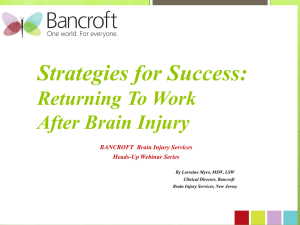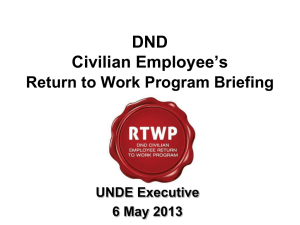Dark Forces in Small Places: Managing Nurses with
advertisement
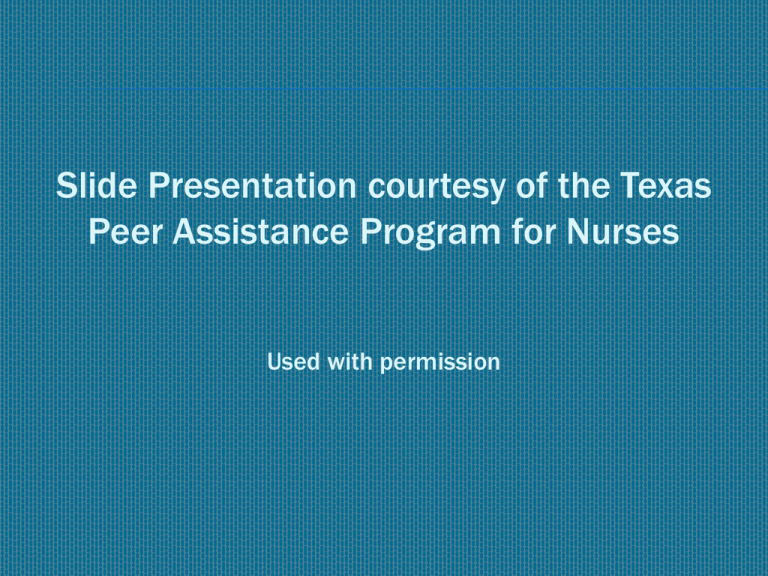
Slide Presentation courtesy of the Texas Peer Assistance Program for Nurses Used with permission Alas, poor Yorick!? LET’S START AT THE VERY BEGINNING The use and abuse of alcohol, tobacco and other drugs is the number ONE public health problem in the US. -RWJF $OBERING DATA Abuse of tobacco and other drugs (ATOD) costs the United States in excess of ½ trillion dollars Looks like this: $500,000,000,000.00+ SOBERING DATA Approximately 60% of all boards of nursing disciplinary cases involve possible substance misuse, abuse, etc. SOBERING DATA 603 Nurses currently active w/TPAPN 20 APNs 138 LVNs 445 RNs We have met the enemy . . . SOBERING DATA Approximately 603 nurses active in TPAPN currently 20 APNs 445 RNs 138 LVNs Photo: Courtesy The Van Doren Company, Inc. SUDS = A BRAIN DISORDER DRUGS ALTER BRAIN FUNCTION 1. Flood brain with excess 2. 3. 4. 5. neurotransmitters (nts) ↑ # receptors for certain nts ↑ sensitivity to certain receptors craving ↓ receptor availability tolerance Inhibit production of nts Courtesy of Hazelden DRUGS ALTER BRAIN FUNCTION CONTINUED 6. Bind to receptors in place of nts 7. Block nts from entering or leaving neuron 8. Empty nts from areas of cells where stored causing the nts to be destroyed 9. Interfere w/reuptake sys. by preventing nts from returning to sending neuron Courtesy of Hazelden DRUGS ALTER BRAIN FUNCTION CONTINUED And we wonder why the “addict” does more of the same “stupid” things Risk Factors for Nurses & Substance Use Disorders Microphotograph – Dopamine - courtesy M. Davidson – F.S.U. HOW WELL DO YOU KNOW . . . Who you are working with? RISK No single factor can predict if someone, let alone a nurse, will become addicted to drugs or alcohol, however . . . RISK FACTORS FOR NURSES Biology/Genes Environment •Social/Family milieu • Cultural attitudes • Genetics •Route • Western medical • Gender •Access practices Drug •Type • Pharmacological • Pre-existing •Cost •Effect optimism disorders & • Unique work Trauma stressors • Behavioral • Enabling staff issues Brain Mechanisms • Administrative • Early use benign neglect •Tobacco use • Availability • Susceptibility • Criminal hx • Lack of Education • Neuroplasticity ADDICTION • Stigma Based on NIDA slide 2007 PUT YOUR HIGH BEAMS ON FOR: 1. Hx: Physical, emotional, or sexual abuse 2. Personal/family hx: MDD or anxiety d/o 3. Family hx: SUDs or ASPD 4. Low threshold for adverse bodily symptoms/psycho-somatic complaints 5. Low impulse control 6. Hx of ↑medical/dental interventions 7. Current dysfunctional or chaotic home (continued) AND LOW-BEAMS THROUGH THE FOG 8. Regular contact w/high-risk people or high risk activities 9. Previous criminal behavior 10.Prior tobacco use 11. Previous treatment for SUDs 12. Pain clinic treatment 13. Hx automobile accidents/DWIs Identifying the Addicted Nurse in the Workplace –sometimes it seems like this! THE LEARNING CURVE OF LIFE PRINCIPLE There are three kinds of people: the one that learns by reading the few who learn by observation And the rest who have to pee on the electric fence for themselves* *Will Rogers Satirist & Political Pundit TOP 10 CLASSIC SIGNS OF SUDS 1. Δs in behaviors & practice usually 2. 3. 4. 5. seen before physical Δs Co-workers observe deteriorating pattern/change over time Work - often the last thing “to go” High level of functioning before “hitting bottom” May justify use, i.e., abuse, with Rxs (continued) Top 10 Classic Signs of SUDs CONTINUED Administers ↑ amount of controlled substances – especially PRNs 7. Notable mood swings over course of shift 8. Increasingly isolated over time 9. Problems, Excuses & DENIAL! 10. At work, but not “on the job.” 6. ABUSE CHARACTERISTICS ( > 1 OR MORE OF THE FOLLOWING IN 12 MO. PERIOD) Recurrent use failure to fulfill major role obligations (work, school or family/home) 2. Recurrent use in physically hazardous situations 3. Recurrent substance-related legal problems 4. Continued use despite persistent or recurrent social/interpersonal problems 1. DEPENDENCY CHARACTERISTICS ( > 3 IN 12 MOS) 1. Tolerance 2. Withdrawal 3. Taken in larger amts than intended or longer 4. 5. 6. 7. than intended Persistent desire or unsuccessful efforts to control use ↑time spent to obtain/use/recover ↑ ↑ social isolation Cont’d use despite adverse consequences: Physical and/or psychological RISK REDUCTION & IDENTIFICATION 1. P&P to support early identification 2. Screen applicants carefully 3. Pre-employment drug test 4. Publicize signs of substance abuse 5. Provide substance abuse CE regularly 6. For-cause & random drug testing 7. Address concerns/discrepancies with on- time performance counseling RISK REDUCTION & IDENTIFICATION CONTINUED 9. Corroborate/document /intervene RE: Concerns 10. Frequent drug admin. audits w/pharmacy 11. Reference P&P, e.g., drug admin. 12. Utilize your EAP/HR – sooner than later 13. Use “SBIRT” 14. Promote smoke-free/drug-free workplace 15. Prohibit work when using controlled substances Rxs Sometimes it seems like this: Some nurses are better than others, which you’ll discover quickly, since a new one will be assigned to you every 30 minutes. Apparently, good nurses burn out rapidly. They must be gathered up and shipped to sanitariums, at which point a new supply is whisked in. . . From: And How Are We Feeling Today By Kathryn Hammer EMPLOYERS + TPAPN Opportunity for nurses to resume nursing practice in an environment that is more safe because the: • People are Informed • Practice is Structured • Predicament is Monitored RE-ENTRY TO PRACTICE: SOMETIMES IT CAN FEEL LIKE THIS! Good judgment comes from experience, and a lot of that comes from bad judgment.* *Will Rogers EMPLOYERS 1. 2. 3. 4. 5. 6. 7. 8. Administrative RTW Meeting Important Points Discuss w/TPAPN case manager Work suspension until TPAPN okays Job duties/concerns Practice environment fit RTW agreement/restrictions (accommodations) Advocate availability Ensure Admin./HR sign off hire EAP/HR involvement Administrative RTW Meeting Important Points continued 9. 10. 11. 12. 13. 14. Ensure understanding of RTW Identify work monitors For-cause UDS (people & process) Any modifications? Nurse held to all P & P Opportunity for nurse to identify: • Possible relapse triggers • Possible cues to relapse EMPLOYERS Clinical RTW Meeting - Important Points 1. Held after admin. RTW mtg. & before actual 2. 3. 4. 5. 6. start of practice Held on need-to-know basis Evaluate resistance/driving forces Opportunity for nurse to briefly disclose & express thanks/hopes Advocate present ideally Co-workers are first-line of defense (continued) CLINICAL RTW MEETING IMPORTANT POINTS CONTINUED 7. Establish “work exchange” (buddy) 8. Education for admin./staff 9. Co-workers are first-line of defense RETURN TO WORK RESTRICTIONS* 1) No autonomous or unsupervised role 2) SUDs or Dual Dx: 6 mos. no access to controlled substances 3) No shifts longer than 12 hours 4) No scheduled OT or on-call for 6 mos 5) No nights 6) No floating – or only limited – with other unit signing RTW *Determined on individual basis - may be modified or waived (continued) RETURN TO WORK RESTRICTIONS* CONTINUED 7) No multiple employers or self-employment 8) No staffing agencies or registries 9) Special RTW addenda for “nurse anesthesia,” “distributive care,” and “nursing academics” *Determined on individual basis - may be modified or waived MONITORING = SUPPORT 1. Address reporting obligations 2. Uphold RTW agreement/monitoring 3. Meet monthly/quarterly with nurse 4. Communicate with TPAPN 5. Enforce boundaries, boundaries, . . . 6. Recognize positive behaviors, but . . . 7. Be alert to reverting to old behaviors 8. Observe: if nothing’s changed – then what’s changed??? TPAPN & BEHAVIORAL RISK MANAGEMENT: THE BAYLOR EXPERIENCE Unpublished Study: Turnover Avoidance and Resulting Cost Savings with RNs Participating in Alternative to Discipline Program Employed at Baylor University Health Care System, Dallas, Texas (1997-2004) Mike Van Doren, MSN, RN, CARN, Program Director, Texas Peer Assistance Program for Nurses (TPAPN) & Connie Bowling, RN, Program Manager, Psychiatry/Addictive Diseases, Baylor University Health Care System, Dallas, Texas BAYLOR HEALTH CARE SYSTEM OUTCOMES (1997 – 2005) Of 96 RNs Identified 81 eligible to participate and signed participation agreement 59 Chemical Dependency 22 Mental Illness BAYLOR HEALTH CARE SYSTEM OUTCOMES 38 successfully completed TPAPN 16 remain active and compliant in TPAPN 11 resigned in good standing during participation 65/81 = 80% Success Rate 16 referred to BNE/employment terminated BAYLOR HEALTH CARE SYSTEM ESTIMATED TURNOVER COST AVOIDANCE Given @80% success rate as measured by documented good performance & adherence to TPAPN over @9 yr period, For a total cost savings = $4,160,000 RELAPSE POTENTIAL IS VERY REAL 1. Exacerbation of disease is normal! 2. Narrow focus of TPAPN intervention 3. Enabling profession 4. Poor capacity for self-care 5. Patient:staff ratios & pt acuity 6. finances/health benefits 7. Limitations of affordable treatment 8. 1st two years = early/fragile time 9. Risk of suicide first two years 10. risk w/poly-substance abuse & injectable hx RELAPSE IS A PROCESS – NOT AN EVENT: It involves Feeling, Thinking, Doing “Addicts” have compliance outcomes comparable to people w/other chronic illnesses Exacerbation of disease will happen to most, to some degree “RELAPSE”: DRUG ADDICTION VS. OTHER CHRONIC ILLNESSES 100 80 50-70% 60 Drug 40-60% 40 50-70% 30-50% 20 Diabetes HTN Asthma 0 Rates Source: McLellan, et al, JAMA 2000 THE RELAPSE PRINCIPLE If you find yourself in a hole, the first thing to do is stop diggin’.* *Will Rogers RE-ENTRY TO PRACTICE Familiarize self w/RTW contract Talk with TPAPN case manager ID/Talk with internal monitors ID nurse’s TPAPN Advocate Consult w/HR & EAP Hold Administrative RTW mtg. (Continued) RE-ENTRY TO PRACTICE Hold Clinical RTW meeting Develop labor exchange Familiarize self w/signs of relapse Be aware of the “Abilene Paradox” ORGANIZATIONAL RISK REDUCTION Microphotograph – Acetylcholine - courtesy M. Davidson – F.S.U. Top Ten TPAPN Myths The only difference between a problem and a solution is that people understand the solution. - Charles Kettering The IMPACT of Curve Balls Nurse’s with impaired practice impact: patient safety ► safety/morale of co-workers ► legal liability ► financial bottom-line ► BUT TPAPN CAN OFF-SET THE CURVE BALLS KEYS TO ORGANIZATIONAL RISK REDUCTION Astute Management Environment Supports: 1. 2. 3. 4. 5. 6. Pro-active P & P SUDs & Psych’ D/Os Pro-active risk management Timely performance counseling Consultation with TPAPN Regular review of drug admin. P&P CE for staff, HR, pharmacy & administration continued KEYS TO ORGANIZATIONAL RISK REDUCTION Astute Management Environment Supports: 7. 8. 9. 10. 11. 12. 13. EAP/HR involvement Assessment/treatment resources Intervention Team Advocacy supported Review of TPAPN hires RTW: Structured/Positive Boundary setting/Tough love WHY SAVE OUR OWN? 1. 2. 3. 4. 5. 6. 7. 8. 9. 10. Humanitarian Fulfill legal obligations professional accountability staff morale patient safety Loss impacts health care delivery Less costly to retain than throw-away Enhance organizational competencies Enhance personal resiliencies Liability concerns - prudently addressed A NURSE MANAGER’S TESTIMONIAL “Thanks TPAPN, she was a good nurse before but through her recovery and participation, as difficult as it was for her at times, she has become an even better nurse!” Excerpt from a nurse manager’s TPAPN evaluation comments WHY SAVE OUR OWN? - A PERSONAL TESTIMONY “. . . thank you for giving me the opportunity to learn about my disease and how to cope with life’s imperfections . . . I am sure this will be a tough time for me and my family, but I also remember the hurt and pain I caused . . . 2 years ago when I lost my job, and almost my career. . . . Again, thank you for this program (TPAPN).” Excerpt from a participant’s letter to her case manager WHY SAVE OUR OWN?: A NURSE MANAGER’S PERSONAL TESTIMONY “Thanks TPAPN, she was a good nurse before but through her recovery and participation, as difficult as it was for her at times, she has become an even better nurse!” Excerpt from a nurse manager’s TPAPN evaluation comments The End


